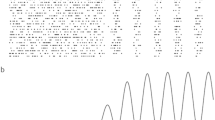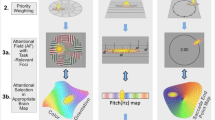Abstract
Studies of embodied cognition have demonstrated the engagement of the motor system when people process action-related words and concepts. However, research using transcranial magnetic stimulation (TMS) to examine linguistic modulation in primary motor cortex has produced inconsistent results. Some studies report that action words produce an increase in corticospinal excitability; others, a decrease. Given the differences in methodology and modality, we re-examined this issue, comparing conditions in which participants either read or listened to the same set of action words. In separate blocks of trials, participants were presented with lists of words in the visual and auditory modality, and a TMS pulse was applied over left motor cortex, either 150 or 300 ms after the word onset. Motor evoked potentials (MEPs) elicited were larger following the presentation of action words compared with control words. However, this effect was only observed when the words were presented visually; no changes in MEPs were found when the words were presented auditorily. A review of the TMS literature on action word processing reveals a similar modality effect on corticospinal excitability. We discuss different hypotheses that might account for this differential modulation of action semantics by vision and audition.



Similar content being viewed by others
Notes
Pulvermuller et al. (2005) applied single-pulse TMS to motor cortex while participants performed a lexical decision task. RTs were influenced in an effector-specific manner. For example, the time to judge that "kick" was a word was faster following TMS directed at the foot area of motor cortex. The authors interpreted this result as indicating that the TMS primed neural activity in the foot area and facilitated the access of an embodied representation. However, the results are also consistent with the hypothesis that the TMS disrupted activity in effector-specific areas that are potential sources of interference for reading comprehension, consistent with the work of Buccino et al. (2005).
References
Aziz-Zadeh L, Maeda F, Zaidel E, Mazziotta J, Iacoboni M (2002) Lateralization in motor facilitation during action observation: a TMS study. Exp Brain Res 144(1):127–131
Aziz-Zadeh L, Wilson SM, Rizzolatti G, Iacoboni M (2006) Congruent embodied representations for visually presented actions and linguistic phrases describing actions. Curr Biol 16(18):1818–1823
Boulenger V, Hauk O, Pulvermuller F (2009) Grasping ideas with the motor system: semantic somatotopy in idiom comprehension. Cereb Cortex 19(8):1905–1914
Buccino G, Binkofski F, Riggio L (2004) The mirror neuron system and action recognition. Brain Lang 89(2):370–376
Buccino G, Riggio L, Melli G, Binkofski F, Gallese V, Rizzolatti G (2005) Listening to action-related sentences modulates the activity of the motor system: a combined TMS and behavioral study. Brain Res 24(3):355–363
Fadiga L, Fogassi L, Pavesi G, Rizzolatti G (1995) Motor facilitation during action observation: a magnetic stimulation study. J Neurophysiol 73(6):2608–2611
Fadiga L, Craighero L, Olivier E (2005) Human motor cortex excitability during the perception of others’ action. Curr Opin Neurobiol 15(2):213–218
Feldman J (2006) From molecule to metaphor. A neural theory of language. The MITT Press, Cambridge
Feldman J, Narayanan S (2004) Embodied meaning in a neural theory of language. Brain Lang 89(2):385–392
Fourkas AD, Avenanti A, Urgesi C, Aglioti SM (2006) Corticospinal facilitation during first and third person imagery. Exp Brain Res 168(1–2):143–151
Gangitano M, Mottaghy FM, Pascual-Leone A (2001) Phase-specific modulation of cortical motor output during movement observation. Neuroreport 12(7):1489–1492
Gazzola V, Keysers C (2009) The observation and execution of actions share motor and somatosensory voxels in all tested subjects: single-subject analyses of unsmoothed fMRI data. Cereb Cortex 19(6):1239–1255
Gazzola V, Aziz-Zadeh L, Keysers C (2006) Empathy and the somatotopic auditory mirror system in humans. Curr Biol 16(18):1824–1829
Glenberg AM, Kaschak MP (2002) Grounding language in action. Psychon Bull Rev 9(3):558–565
Glenberg AM, Sato M, Cattaneo L, Riggio L, Palumbo D, Buccino G (2008) Processing abstract language modulates motor system activity. Q J Exp Psychol 61(6):905–919
Hauk O, Johnsrude I, Pulvermuller F (2004) Somatotopic representation of action words in human motor and premotor cortex. Neuron 41(2):301–307
Hauk O, Shtyrov Y, Pulvermuller F (2008) The time course of action and action-word comprehension in the human brain as revealed by neurophysiology. J Physiol, Paris 102(1–3):50–58
Kohler E, Keysers C, Umilta MA, Fogassi L, Gallese V, Rizzolatti G (2002) Hearing sounds, understanding actions: action representation in mirror neurons. Science (New York, NY) 297(5582):846–848
Labruna L, Fernández-del-Olmo M, Ivry RB Comparison of different baseline conditions in evaluating factors that influence motor cortex excitability. Brain Stimul (in press)
Lahav A, Saltzman E, Schlaug G (2007) Action representation of sound: audiomotor recognition network while listening to newly acquired actions. J Neurosci 27(2):308–314
Liberman AM, Mattingly IG (1989) A specialization for speech perception. Science (New York, NY) 243(4890):489–494
Mahon BZ, Caramazza A (2008) A critical look at the embodied cognition hypothesis and a new proposal for grounding conceptual content. J Physiol, Paris 102(1–3):59–70
Morin O, Grezes J (2008) What is “mirror” in the premotor cortex? A review. Neurophysiol Clin 38(3):189–195
Oldfield RC (1971) The assessment and analysis of handedness: the Edinburgh inventory. Neuropsychologia 9(1):97–113
Oliveri M, Finocchiaro C, Shapiro K, Gangitano M, Caramazza A, Pascual-Leone A (2004) All talk and no action: a transcranial magnetic stimulation study of motor cortex activation during action word production. J Cogn Neurosci 16(3):374–381
Papeo L, Vallesi A, Isaja A, Rumiati RI (2009) Effects of TMS on different stages of motor and non-motor verb processing in the primary motor cortex. PloS One 4(2):e4508
Patuzzo S, Fiaschi A, Manganotti P (2003) Modulation of motor cortex excitability in the left hemisphere during action observation: a single- and paired-pulse transcranial magnetic stimulation study of self- and non-self-action observation. Neuropsychologia 41(9):1272–1278
Pizzamiglio L, Aprile T, Spitoni G, Pitzalis S, Bates E, D’Amico S et al (2005) Separate neural systems for processing action- or non-action-related sounds. NeuroImage 24(3):852–861
Pulvermuller F, Fadiga L (2010) Active perception: sensorimotor circuits as a cortical basis for language. Nat rev 11(5):351–360
Pulvermuller F, Hauk O, Nikulin VV, Ilmoniemi RJ (2005) Functional links between motor and language systems. Eur J Neurosci 21(3):793–797
Recanzone GH (2009) Interactions of auditory and visual stimuli in space and time. Hear Res 258(1–2):89–99
Rizzolatti G, Craighero L (2004) The mirror-neuron system. Annu Rev Neurosci 27:169–192
Shtyrov Y, Kujala T, Pulvermuller F (2010) Interactions between language and attention systems: early automatic lexical processing? J Cogn Neurosci 22(7):1465–1478
Strafella AP, Paus T (2000) Modulation of cortical excitability during action observation: a transcranial magnetic stimulation study. Neuroreport 11(10):2289–2292
Tettamanti M, Buccino G, Saccuman MC, Gallese V, Danna M, Scifo P et al (2005) Listening to action-related sentences activates fronto-parietal motor circuits. J Cogn Neurosci 17(2):273–281
Tomasino B, Fink GR, Sparing R, Dafotakis M, Weiss PH (2008) Action verbs and the primary motor cortex: a comparative TMS study of silent reading, frequency judgments, and motor imagery. Neuropsychologia 46(7):1915–1926
Acknowledgments
This work was supported by a grant from the US-Israel Binational Science Foundation (BSF007350) and a grant from Xunta de Galicia, Spain (PGIDIT06PXIB160333PR).
Author information
Authors and Affiliations
Corresponding author
Rights and permissions
About this article
Cite this article
Labruna, L., Fernández-del-Olmo, M., Landau, A. et al. Modulation of the motor system during visual and auditory language processing. Exp Brain Res 211, 243–250 (2011). https://doi.org/10.1007/s00221-011-2678-z
Received:
Accepted:
Published:
Issue Date:
DOI: https://doi.org/10.1007/s00221-011-2678-z




